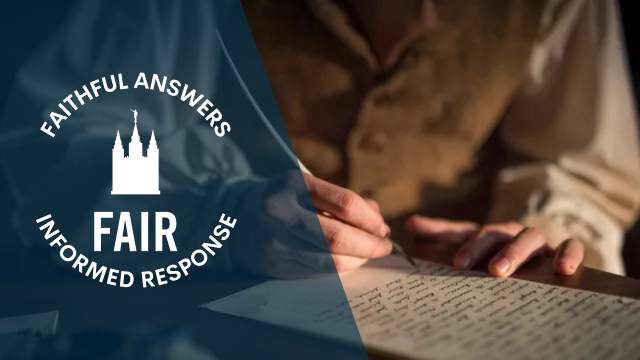
FAIR is a non-profit organization dedicated to providing well-documented answers to criticisms of the doctrine, practice, and history of The Church of Jesus Christ of Latter-day Saints.
FAIR › Scripture Study Resources: Supplement Your Come, Follow Me Study › Study Resources for the Doctrine & Covenants and Church History › Week 6 This Is the Spirit of Revelation

The Lord taught Oliver Cowdery that revelation would come to his mind and heart by the Holy Ghost (D&C 8:2-3). Sometimes, we expect revelation to be dramatic or unmistakable, but more often, it comes gently as impressions, thoughts, and feelings. President Russell M. Nelson emphasized that increasing purity, obedience, and daily study of the Book of Mormon enhances our ability to receive revelation6 Revelation.
If you have questions on this week’s reading, please email your questions to us here.
Logical Analysis: If Joseph had plagiarized or fabricated the text, there should be evidence of source materials or earlier drafts, yet none have been found. The book’s complexity, internal consistency, and historical authenticity exceed what would be expected from an uneducated 19th-century farm boy.
Practical solutions for someone in faith crisis:
Action Step: Dedicate time each day to study the scriptures and seek revelation through prayer.
Encouraging Thought: President Russell M. Nelson taught, “Nothing opens the heavens quite like the combination of increased purity, exact obedience, earnest seeking, daily feasting on the words of Christ, and regular time committed to temple and family history work.”
Action Step: Memorize and apply Doctrine and Covenants 6:36: “Look unto me in every thought; doubt not, fear not.”
Fear often prevents us from acting on spiritual impressions. The Lord’s counsel to Oliver Cowdery reminds us that focusing on Christ dispels doubt and fear. By shifting our mindset to trust in Christ’s promises, we can move forward in faith rather than being paralyzed by uncertainty.
Encouraging Thought:
Elder Jeffrey R. Holland said, “Fear not. Believe only. God has great things in store for you. Trust in Him. Trust in His love.”
Keep a revelation journal to recognize how the Lord speaks to you.
Encouraging Thought:
Elder Richard G. Scott taught, “Spiritual experiences require reflection to be truly meaningful. Recording them will help you recognize God’s hand in your life and increase your ability to receive personal revelation.”
Objective: Help learners understand that receiving revelation is a process that requires both study and faith.
Follow-Up Question: How can we recognize when revelation is from God and not just our own thoughts?
Objective: Teach learners how to replace fear and doubt with faith by focusing on Jesus Christ.
Follow-Up Question: What practical ways can we “look to Christ in every thought” during daily life?
Objective: Demonstrate how revelation follows a process of effort, asking, and spiritual confirmation.
Follow-Up Question: How can we recognize when we have received an answer from God?

FAIR is a non-profit organization dedicated to providing well-documented answers to criticisms of the doctrine, practice, and history of The Church of Jesus Christ of Latter-day Saints.
We are a volunteer organization. We invite you to give back.
Donate Now